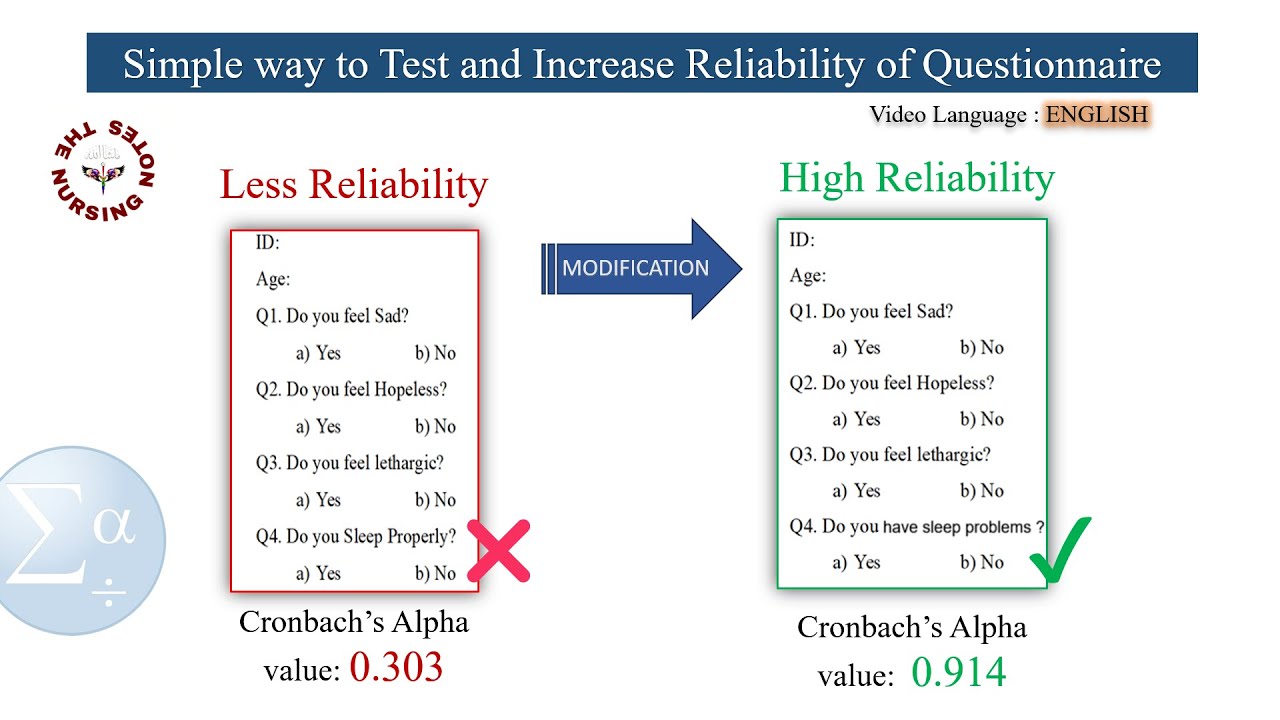Negative Cronbach's alpha???
TLDRIn this informative video, Christian Geiser addresses the issue of negative Cronbach's Alpha, a measure of reliability in classical test theory, which is typically expected to range between 0 and 1. He explains that a negative Alpha value is nonsensical as it implies negative true score variance, which is not possible. Using an online Cronbach's Alpha calculator developed by Dr. Patrick Wesa, Geiser illustrates that a negative Alpha can occur when an item in a set is reverse-coded, leading to negative correlations with other items. He emphasizes the importance of checking item coding and inter-item correlations to ensure all items measure a single factor with equal loadings, which is a prerequisite for using Cronbach's Alpha. If negative correlations are found, it suggests a data error or improper variable selection. The video serves as a helpful guide for those encountering unexpected results when assessing the reliability of their data sets.
Takeaways
- 📊 Chronbach's Alpha is a measure of reliability used in classical test theory for items that are assumed to measure a single factor with equal loadings.
- 🚫 A negative Cronbach's Alpha value is not logically possible as it should range between 0 and 1, indicating the proportion of true score variance.
- 🔍 If you encounter a negative Cronbach's Alpha, check for data entry errors, such as improper recoding of items, which could lead to negative correlations.
- ✅ The assumption of tau-equivalence implies that all item covariances should be positive and of the same magnitude.
- 🔄 Re-coding reverse-scored items to ensure positive inter-item correlations is crucial for the validity of Cronbach's Alpha.
- 📋 The video uses a free online Cronbach's Alpha calculator developed by Dr. Patrick M. Wessa to illustrate the concepts.
- 💻 The online calculator can also compute Alpha if a specific item is deleted, which can help identify problematic items in a scale.
- 📉 Excluding an item with a negative correlation can result in a more positive (but still incorrect) Alpha value, indicating the need for recoding.
- 📈 After recoding, the online calculator recomputes Cronbach's Alpha, which should then fall within an acceptable range.
- 🔗 It is important to cite the reference of any tools or software used in your analysis, such as the online Cronbach's Alpha calculator.
- 📚 Understanding when and why Cronbach's Alpha might be negative can help in identifying and correcting errors in psychometric analysis.
- 🔍 Always check inter-item correlations and ensure that all items are properly recoded before computing Cronbach's Alpha.
Q & A
What is Cronbach's Alpha and what does it measure?
-Cronbach's Alpha is a measure of reliability derived from classical test theory. It assesses the degree to which a set of items (e.g., questions in a survey) measures a single unidimensional latent construct with equal loadings. It is used to estimate the internal consistency or reliability of a set of items that are assumed to be tau-equivalent or essentially tau-equivalent.
Why can't Cronbach's Alpha be negative according to classical test theory?
-Cronbach's Alpha is a coefficient of determination, similar to an r-squared measure, where zero indicates no true score variance and one indicates all variance is true score variance. Negative values do not make sense in this context because variance cannot be negative.
What does it mean if Cronbach's Alpha is negative in your data?
-A negative Cronbach's Alpha suggests that there is an error in the data or the way items have been recorded. It could indicate that an item has been reverse coded, resulting in a negative correlation with other items, which violates the assumptions of tau-equivalence.
What should you do if you find a negative Cronbach's Alpha in your data?
-First, check if the items have been properly recoded, especially for reverse-coded items. If recoding is not the issue, look for data errors such as incorrect data import or calculation mistakes. Negative Alpha indicates a problem with the inter-item correlations, which should be positive and of the same magnitude for tau-equivalence.
How can using an online Cronbach's Alpha calculator help in analyzing your data?
-An online Cronbach's Alpha calculator allows you to input your data and compute the Alpha measure for free. It can also provide additional insights, such as the Alpha value if a specific item is deleted from the composite, which can help identify problematic items that may be negatively impacting the overall reliability.
What does it imply if all item covariances are positive and the same in a set of items?
-If all item covariances are positive and the same, it implies that the items are tau-equivalent, meaning they all measure the same latent factor with equal loadings. This is a key assumption for using Cronbach's Alpha as a measure of reliability.
What is the range of possible values for Cronbach's Alpha?
-Cronbach's Alpha can only take on values between 0 and 1, inclusive. A value of 0 indicates no reliability (no true score variance), while a value of 1 indicates perfect reliability (all variance is true score variance).
What happens if an item in your dataset has a different polarity compared to the others?
-If an item has a different polarity (e.g., it is reverse coded), it will correlate negatively with the other items, leading to a negative Cronbach's Alpha if not properly accounted for. This violates the assumptions of the classical test theory model and thus affects the reliability of the composite measure.
How can you ensure that all items in your dataset are properly recoded?
-To ensure proper recoding, you should check each item's correlation with the others. If an item correlates negatively, it may need to be recoded. Some online Cronbach's Alpha calculators have a feature to check for and correct reverse coding automatically.
What is the implication of having a Cronbach's Alpha value greater than 0 but less than the desired threshold for reliability?
-An Alpha value greater than 0 but below the threshold (commonly 0.7) suggests that while the items are somewhat reliable, they may not be consistently measuring the intended construct. It could indicate the need for additional items, revision of existing items, or a reevaluation of the scale's unidimensionality.
Can you use Cronbach's Alpha for scales that are not unidimensional?
-Cronbach's Alpha is most appropriate for unidimensional scales. If a scale is multidimensional, meaning it measures more than one underlying construct, other reliability measures or confirmatory factor analysis might be more suitable to assess the internal consistency of the scale.
What are some common mistakes that can lead to a negative Cronbach's Alpha value?
-Common mistakes include reverse coding items without proper recoding, data entry errors, incorrect data import into the software, and analyzing variables that do not conform to the model of tau-equivalence. It's crucial to verify the data and the assumptions underlying the use of Cronbach's Alpha before interpreting the results.
Outlines
🤔 Understanding Negative Cronbach's Alpha
In this paragraph, Christian Geiser introduces the topic of the video, which is about addressing the issue of negative Cronbach's Alpha values. He explains that Cronbach's Alpha is a measure of reliability from classical test theory, assuming that all items in a test measure a single latent factor with equal loadings. The video aims to clarify why negative Alpha values can occur and what to do about them. An online calculator by Dr. Patrick Wesa is mentioned as a useful tool for calculating Cronbach's Alpha, and viewers are encouraged to use and cite it if needed. An example is provided where the Alpha for three items (Y1, Y2, Y3) is negative, highlighting the confusion this can cause since reliability measures should theoretically range between 0 and 1.
🔍 Investigating the Cause of Negative Cronbach's Alpha
The second paragraph delves into why Cronbach's Alpha might be negative. It is revealed that the issue stems from one of the items (Y3) having a reverse-coded polarity, resulting in a negative correlation with the other two items. This violates the assumptions of essential tau-equivalence or strict tau-equivalence, where all item covariances should be positive. The video suggests that if an item correlates negatively with others, it should be recoded to ensure positive covariances. The online calculator is shown to provide additional insights, such as the Alpha value when an item is deleted from the composite. By recomputing with the correct recoding, a more sensible positive Alpha value is obtained, indicating that the initial negative value was likely due to a data error or improper recoding.
📚 Conclusion and Further Resources
In the final paragraph, the video concludes by emphasizing that a negative Cronbach's Alpha is not logically possible and suggests that if encountered, it is indicative of a data error or incorrect variable analysis. The video encourages viewers to check inter-item correlations for any negative values, which could be the cause of the issue. The presenter, Christian Geiser, invites viewers to subscribe to the channel, like the video, and explore additional resources provided in the video description. He also encourages engagement through comments and looks forward to the next video.
Mindmap
Keywords
💡Cronbach's Alpha
💡Negative Cronbach's Alpha
💡Tau Equivalence
💡Reverse Coding
💡Online Calculator
💡Psychometrics
💡Multivariate Statistical Methods
💡Structural Equation Modeling (SEM)
💡Latent Class Analysis (LCA)
💡M plus Software
💡Data Error
Highlights
Christian Geiser discusses the concept of Cronbach's Alpha and its interpretation in the context of psychometrics.
Cronbach's Alpha is a measure of reliability derived from classical test theory, assuming a model of tau equivalence.
The video addresses the question of why Cronbach's Alpha can be negative and what it signifies.
A free online Cronbach's Alpha calculator developed by Dr. Patrick Wesa is introduced and recommended for its utility.
The calculator can compute Cronbach's Alpha from user-provided data and also provides Alpha values when an item is deleted from the composite.
A negative Cronbach's Alpha value indicates a potential issue with the data, such as an item being reverse coded.
The video demonstrates how to identify and correct for a reverse-coded item using the online calculator.
Cronbach's Alpha should only range between 0 and 1, with negative values suggesting an error in the data or the analysis.
The video illustrates the process of recoding an item to ensure positive covariances among all items in a scale.
It is emphasized that all items in a scale should correlate positively to meet the assumptions of unidimensionality.
The video provides a step-by-step guide on how to use the online calculator, including checking for negative coding.
Christian Geiser explains that if Cronbach's Alpha is negative, one should first check the recoding of items, then look for data errors.
The video concludes with advice on checking inter-item correlations for any negative values, which could cause a negative Alpha.
The presenter encourages viewers to subscribe to the channel for more tutorials on psychometrics and multivariate statistical methods.
The video offers additional resources, including free videos and workshops, for further learning on Cronbach's Alpha and related topics.
Christian Geiser invites viewers to leave comments for discussion and to look forward to the next weekly video on the channel.
Transcripts
Browse More Related Video

Calculating and Interpreting Cronbach's Alpha Using SPSS

What is Cronbach's Alpha? - Explained Simply (Part 2)

What is Cronbach's Alpha? - Explained Simply

Cronbach's alpha or Coefficient alpha in simple language - DU Professor

Cronbach's Alpha - Excel

Mastering to Increase Cronbach's alpha value | Reliability Test | Simple| using SPSS
5.0 / 5 (0 votes)
Thanks for rating: